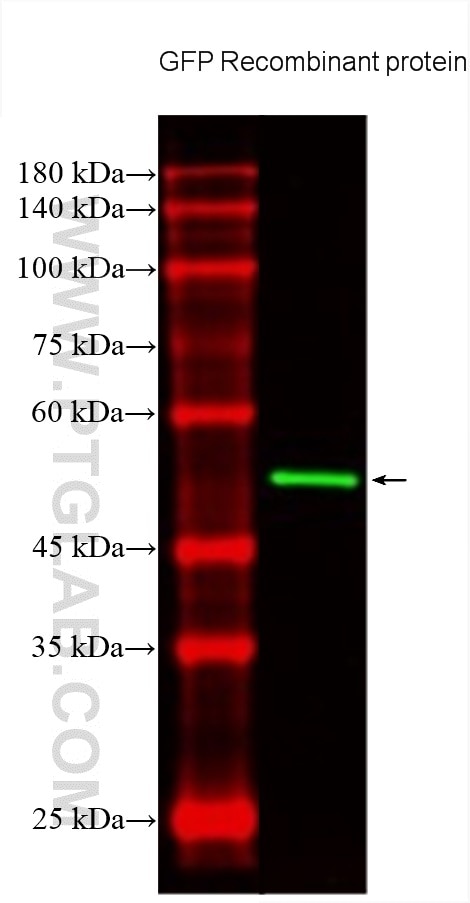Anticorps Monoclonal anti-GFP tag
GFP tag Monoclonal Antibody for IF, WB
Hôte / Isotype
Mouse / IgG2a
Réactivité testée
Protéine recombinante
Applications
WB, IF
Conjugaison
CoraLite® Plus 488 Fluorescent Dye
CloneNo.
1E10H7
N° de cat : CL488-66002
Synonymes
Galerie de données de validation
Applications testées
| Résultats positifs en WB | Protéine recombinante, |
| Résultats positifs en IF | cellules HEK-293 transfectées, |
Dilution recommandée
| Application | Dilution |
|---|---|
| Western Blot (WB) | WB : 1:2000-1:10000 |
| Immunofluorescence (IF) | IF : 1:50-1:500 |
| It is recommended that this reagent should be titrated in each testing system to obtain optimal results. | |
| Sample-dependent, check data in validation data gallery | |
Informations sur le produit
CL488-66002 cible GFP tag dans les applications de WB, IF et montre une réactivité avec des échantillons Protéine recombinante
| Réactivité | Protéine recombinante |
| Hôte / Isotype | Mouse / IgG2a |
| Clonalité | Monoclonal |
| Type | Anticorps |
| Immunogène | GFP tag Protéine recombinante Ag2128 |
| Nom complet | GFP tag |
| Masse moléculaire calculée | 26 kDa |
| Numéro d’acquisition GenBank | U73901 |
| Symbole du gène | |
| Identification du gène (NCBI) | |
| Conjugaison | CoraLite® Plus 488 Fluorescent Dye |
| Excitation/Emission maxima wavelengths | 493 nm / 522 nm |
| Forme | Liquide |
| Méthode de purification | Purification par protéine A |
| Tampon de stockage | PBS avec glycérol à 50 %, Proclin300 à 0,05 % et BSA à 0,5 %, pH 7,3. |
| Conditions de stockage | Stocker à -20 °C. Éviter toute exposition à la lumière. Stable pendant un an après l'expédition. L'aliquotage n'est pas nécessaire pour le stockage à -20oC Les 20ul contiennent 0,1% de BSA. |
Informations générales
Green fluorescence protein (GFP) is a protein composed of 238 amino acid residues (26.9kDa) derived from the jellyfish Aequorea Victoria which emits green light (emission peak at 509nm) when excited by blue light (excitation peak at 395nm). GFP, when exposed to light in the blue to ultraviolet spectrum, will show a bright green fluorescent light, making it a very useful tool in research.
What is the molecular weight of GFP?
26.9 kDa
How does GFP work?
GFP was first isolated from the jellyfish Aequorea Victoria, a source of bioluminescence, in the 1960s and in 2008 the Nobel Prize in Chemistry was awarded "for the discovery and development of the green fluorescent protein, GFP" to Osamu Shimomura and colleagues, who recognized its potential in research (PMID: 13911999). A short amino acid sequence within the protein acts as the chromophore, which absorbs UV light at 395 nm and emits green light at 509 nm.
Why is GFP a useful reporter?
When GFP was sequenced in 1992 (PMID: 1347277) it allowed scientists to express it in other organisms using transgenic techniques. It does not require cofactors to work, is non-toxic to live cells, and is relatively small, making it ideal as a "tag" for other proteins, identifiable by shining a UV light and observing the green fluorescence. The tertiary folded structure of GFP forms a chromophore at the center of a barrel shape, which protects the fluorescence-emitting amino acid chain from solvents, meaning it can function in many environments (PMID 9759496).
What are the applications for GFP?
When expressed attached to another protein, GFP can be used as a reporter gene to measure expression levels or can easily be used in fluorescence microscopy. It has been used to highlight proteins in a variety of model organisms, including bacteria, zebrafish, and mice.
Protocole
| Product Specific Protocols | |
|---|---|
| WB protocol for CL Plus 488 GFP tag antibody CL488-66002 | Download protocol |
| IF protocol for CL Plus 488 GFP tag antibody CL488-66002 | Download protocol |
| Standard Protocols | |
|---|---|
| Click here to view our Standard Protocols |



